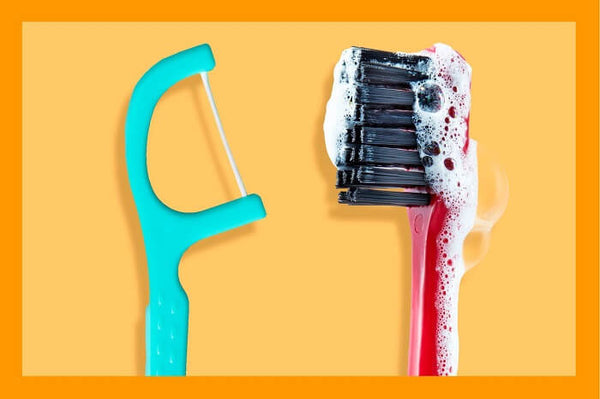Key Takeaway:
There is no right or wrong time to floss as long as you are doing it the right way, consistently. However, it is better to floss before brushing to remove the tiny leftover food particles stuck in your teeth.
What if we say you have been living a lie that you should floss your teeth after brushing? Well, it’s not exactly a lie, but new research says that you can floss your teeth anytime before and after brushing.
So, should you floss your teeth after brushing? Or what difference does it make if you floss before brushing? After receiving such questions, we decided to do a short guide explaining when is the right time to floss and what dental experts have to say about it.
Here is what American Dental Association says:
Flossing is an effective way to prevent tooth decay. It clears the plaque accumulating between teeth and removes debris from hard-to-reach areas.ADA recommends brushing your teeth twice a day and flossing once a day. But the question remains there, should you floss before or after brushing?
Surprisingly, there is no hard and fast rule when one must floss. One should do it whenever it is fit to their routine. However, it should not exceed more than once a day. Also, as long as you are doing it right, the timing does not matter.
Why Should You Floss before Brushing your Teeth?
While it is acceptable either way, some studies suggest that flossing before brushing is more effective than flossing after brushing. A 2018 study on a small group of individuals showed that flossing before brushing helps reduce plaque buildup significantly compared to when done after brushing.
Flossing before brushing helps loosen bits and pieces stuck between teeth and clear them out after brushing.
What Happens if you Floss your Teeth after Brushing?

Even if you floss after brushing, there is nothing to be worried about. Until and unless you do it regularly, you are on the right track. In fact, UCLA School of Dentistry professor Dr. Edmond Hewlett says, "Dentists just want you to floss."
Apart from that, some people also ask for the right time to floss. Time doesn’t matter if you are doing it the right way. If you feel like doing it in the morning rather than the evening, it’s perfectly fine.
How to Floss the Right Way - 5 Steps
Now that you know that timing doesn’t matter when it comes to flossing, it’s time to learn how to floss the right way. Here is a 5 steps guide to a perfect flossing technique.
- Cut about 18 to 24 inches of floss and wrap both ends to each hand’s center fingers, leaving only 2 to 3 inches of floss for your teeth.
- Next, hold the floss from your thumbs and forefingers of both hands.
- Guide the dental floss between your teeth and gradually glide it up and down in a rubbing motion. Be careful not to place the floss in your gums as it will scratch or bruise them.
- When the floss reaches the gums, curve it to make a C shape, and that’s how it will pull out all the dirt and debris.
- Repeat the steps as you move forward to clean the next tooth.
How to Make Flossing Part of your Routine?
Very few people have flossing as part of their daily routine. In fact, a study revealed that 39 percent of males and 27 percent of females in the US never floss. Only 68 percent of people reported flossing once a week.
If you are already struggling with brushing your teeth twice a day, adding flossing to your routine may sound like a big task. But know that flossing is equally important as brushing. It saves your teeth from decay and protects their fluoride content.
To make it a habit, set a time in a day to floss your teeth, followed by brushing or brushing first, then flossing however you feel like. While there is no established rule for brushing and flossing, it would be great to floss first and then brush later.
Conclusion
Flossing is an important part of dental care. If you do it once a day, you are on the right path. Also, make sure you floss following the 5 steps mentioned above and rinse your mouth afterwards to remove leftover food particles.

